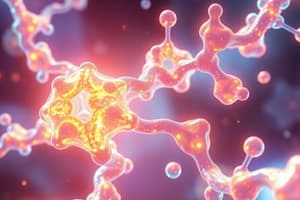Podcast
Questions and Answers
What type of bonds form between amino and carboxyl groups in proteins?
What type of bonds form between amino and carboxyl groups in proteins?
- Covalent bonds
- Peptide bonds (correct)
- Hydrogen bonds
- Ionic bonds
Which level of protein structure is primarily determined by interactions among R groups of amino acids?
Which level of protein structure is primarily determined by interactions among R groups of amino acids?
- Primary structure
- Secondary structure
- Quaternary structure
- Tertiary structure (correct)
What happens to protein structure during denaturation?
What happens to protein structure during denaturation?
- Ionic bonds are strengthened
- Peptide bonds are weakened
- Hydrogen bonds are disrupted (correct)
- Covalent bonds are formed
Which carbohydrate serves as a primary source of energy and structural material?
Which carbohydrate serves as a primary source of energy and structural material?
What type of molecules are lipids based on their hydrophobic characteristic?
What type of molecules are lipids based on their hydrophobic characteristic?
What is the primary purpose of the video mentioned?
What is the primary purpose of the video mentioned?
Which of the following is NOT a unique property of water?
Which of the following is NOT a unique property of water?
What are the most common elements found in living organisms?
What are the most common elements found in living organisms?
What is the role of metabolism in organisms?
What is the role of metabolism in organisms?
What are amino acids characterized by?
What are amino acids characterized by?
Study Notes
- The video provides a recap of AP Biology Unit 1: Chemistry of Life, offering resources for studying for unit tests, midterm exams, final exams, and the AP Biology exam in May.
- Viewers are encouraged to actively engage by using the provided Ultimate Review Packet, which includes study guides, practice questions, and more.
- The importance of understanding the chemistry of life, particularly the structure of water and hydrogen bonding, is highlighted as a foundation for biological concepts.
- Water's unique properties, such as cohesion, adhesion, and surface tension, are explained in detail, emphasizing their significance in biological processes.
- The text delves into the elements of life, discussing the composition of matter, subatomic particles (protons, neutrons, electrons), and the role of metabolism in organisms.
- Organic molecules contain carbon and are essential for biological processes, with CHNOPS (Carbon, Hydrogen, Nitrogen, Oxygen, Phosphorus, Sulfur) being the most common elements in living things.
- An introduction to biological macromolecules is provided, explaining dehydration reactions to form polymers and hydrolysis reactions to break polymers into monomers.- Proteins are polymers made up of amino acid monomers, each containing a central carbon atom with four single covalent bonds.
- Amino acids have unique properties based on their R group side chains, such as hydrophobic, hydrophilic, or ionic characteristics.
- Peptide bonds form through dehydration synthesis between amino and carboxyl groups, creating polypeptides which are the primary structure of proteins.
- Proteins have four levels of structure: primary, secondary (alpha helix or beta pleated sheet), tertiary (3D shape due to R group interactions), and quaternary (multiple amino acid chains interacting).
- Protein structure is influenced by R group chemical properties and environmental factors, with denaturation occurring when hydrogen bonds are disrupted.
- Proteins play various crucial roles in cellular membranes, acting in transport, recognition, movement, communication, and enzymatic functions.
- Carbohydrates are polysaccharides formed from monosaccharide monomers, serving as a primary source of energy and structural material.
- Different types of carbohydrates like glucose, fructose, and cellulose have distinct structures and functions based on glycosidic linkages and branching patterns.
- Lipids are diverse hydrophobic molecules including fats, phospholipids, and steroids, with unique structures for specific biological roles.
- Nucleic acids like DNA and RNA transmit genetic information through nucleotides containing pentose sugars, phosphate groups, and nitrogenous bases.
- Water's polarity influences its properties like hydrogen bonding, cohesion, adhesion, and surface tension, crucial for various biological processes.
Studying That Suits You
Use AI to generate personalized quizzes and flashcards to suit your learning preferences.
Description
A comprehensive review of Unit 1: Chemistry of Life in AP Biology, covering topics such as the structure of water, elements of life, organic molecules, biological macromolecules, and the roles of proteins, carbohydrates, lipids, and nucleic acids in living organisms. The recap emphasizes the importance of understanding foundational concepts for succeeding in unit tests, exams, and the AP Biology exam in May.




